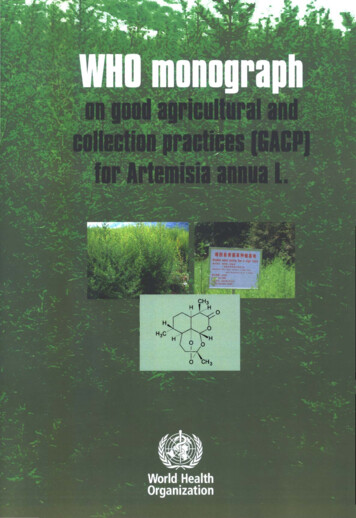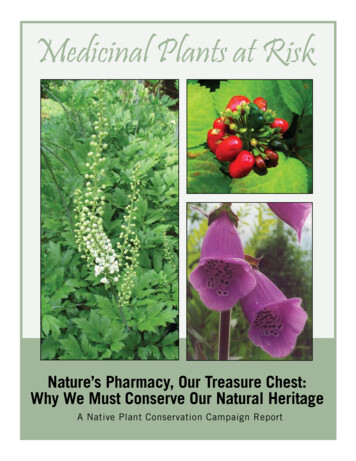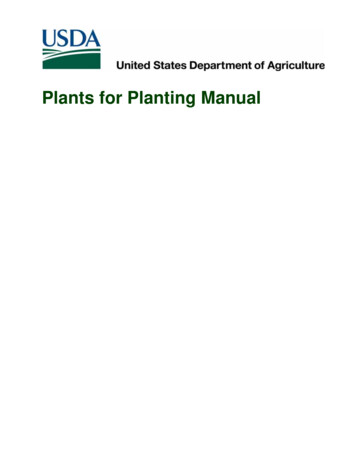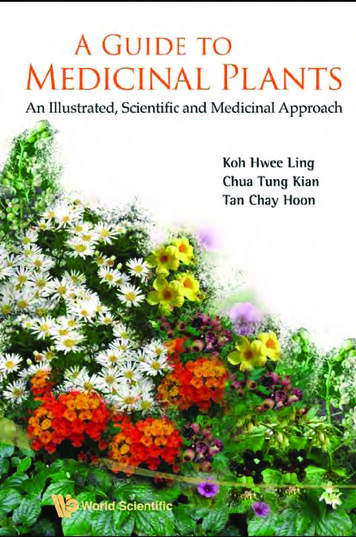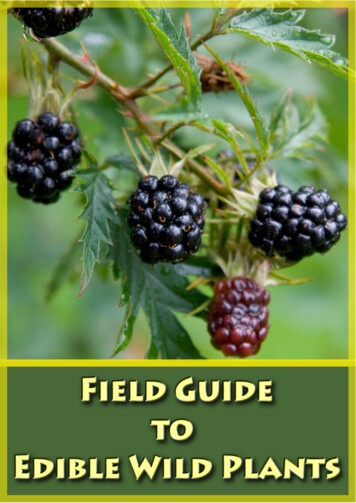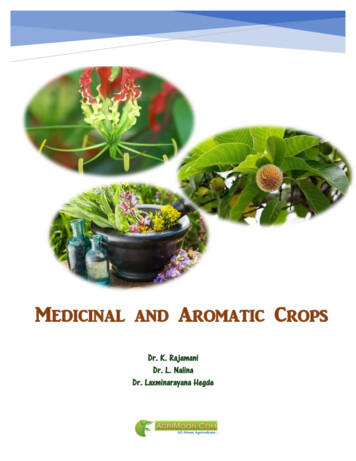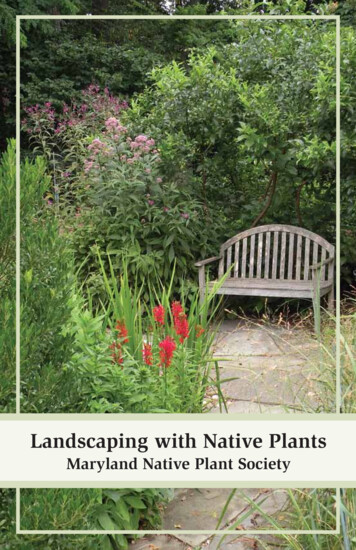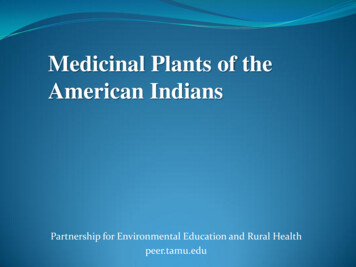
Transcription
Medicinal Plants of theAmerican IndiansPartnership for Environmental Education and Rural Healthpeer.tamu.edu
American Indian Medicine Practice The meaning of the term medicine to an AmericanIndian is quite different from that which is ordinarilyheld by modern societies. To most American Indians, medicine signifies an arrayof ideas and concepts rather than remedies andtreatment alone.
American Indian Medicine Practice There are variations in healing procedure from tribe totribe and in different cultural areas. However, thereare some methods which are nearly universal. Common methods of treatment include prayer,chanting, music, herbalism, counseling, andceremony.
Herbs as Medicine The herbs employed by the medicine men are believedto derive their strength from the ceremoniesperformed to make them powerful. “Like cures like” was the essence of their herbalbelief. Yellow plants are good for jaundice; red ones aregood for the blood.American Indian medicinebags
Herbs as Medicine Some part of the plant might resemble the organ of thebody it is designed to cure. The use of wormroot for worms, snakeroot for fits, elmbark is used for bleeding lungs because of its slipperyquality and bloodroot is used to prevent bleeding.WormrootSnakerootElm BarkBloodroot
Herbs as Medicine The Indians also commonly believed that certain rootsor plants were beneficial to the system because theyare distasteful and injurious to the demons causingdisease in the host body. Foul-tasting medicines, emetics, and purges are oftenused.
Herbs as Medicine There are hundreds of plants that were used by NativeAmericans as medicines. Discussion of all of them is beyond the scope of thislecture. The most common and widely used plants arediscussed.
Barberry Barberis genus Anthropologists believe in a ritual practice orsacred object, especially by Native Americans thatit works as a supernatural power or as preventive orremedy of illness. It is the most widely used drug in Homeopathicsystem of medicine for kidney pain and forremoval of kidney stones
Candle Bush Cassia alata Leaves or sap are used to treat fungal infections such asringworm. They contain a fungicide, chrysophanicacid. Besides skin diseases, it is also used to treat a widerange of ailments from stomach problems, fever,asthma to snake bite and venereal diseases (syphilis,gonorrhoea).
Horsemint Monarda genus Long history of use as a medicinal plants by manyNative Americans including the Blackfeet,Menominee, Ojibwa, Winnebago and others. Used for skin infections and minor wounds infectionscaused by dental caries and gingivitis excessiveflatulence
Cascara Buckthorn Rhamnus purshiana The dried, aged bark of this tree has been usedcontinually for at least 1,000 years by both native andEuropean settlers as a laxative natural medicine.
Cinchona Cinchona sp. The bark of trees in this genus is the source of a varietyof alkaloids, the most familiar of which is quinine, ananti-fever agent especially useful in treating malaria. Native Americans used it for fever and chill, that maybe associated with malaria.
Juniper Juniperus sp. Juniper berries were used by American Indians as aherbal remedy for urinary tract infections as well as afemale contraceptives. Western tribes combined the berries of Juniperuscommunis with Barberis root bark in a herbal tea totreat diabetes.
Willow Salix sp. Native Americans across the American continentrelied on it as a staple of their medical treatments. The leaves and bark of the willow tree contain salicylicacid, the precursor to aspirin.
Dogwood Cornus florida Native Americans used dogwood bark for variety ofillnesses. A drink can be made from the bark, flowers and fruitto reduce fever and relieve chills. It can also be used as a remedy for colic.
Geranium Geranium sp. Geranium roots has astringent effects. It was used to treat thrush, a contagious disease causedby a fungus, affects mostly infants and children.
Ginseng Panax quinquefolium Ginseng root was used by native Americans forcramps, menstrual problems, headaches, and stroke. It was taken as a tonic to increase mental powers,prevent shock, and a treatment for asthma andemphysema.
Wormseed Chenopodium ambrosioides For centuries, the Maya of Central America usedWormseed to expel worms, and hence its name. Aztecsused the plant to treat asthma and dysentery. The Catawaba peoples of the US used the plant forpoultices to detoxify snake bites and other poisonings.
White Hellebore Veratrum viride It is a highly toxic plant that was widely employedmedicinally by several native North American Indiantribes who used it mainly externally in the treatmentof wounds and pain.
Greek Valerian Polemonium reptans RANGE: Northeastern United States, south to Georgiaand west to Minnesota and Oklahoma Native Americans used the root for piles orhemorrhoids, to induce sweating and vomiting, totreat eczema (inflammation of the epidermis).
Elderberry Sambucus canadensis Native North American tribes used it to treat a widerange of complaints like cold, consumption, headache,indigestion etc. All parts of the elderberry plant are considered to be avaluable healing plant in many folk medicinetraditions.
Angelica Angelica atropurpurea Native to eastern North America. Angelica was held in high esteem by Indians inArkansas, who always carried it in their medicinebags and mixed it with tobacco for smoking. Relieves menstrual discomfort, minimizessymptoms of menopause, treats colds and otherrespiratory problems, prevents arthritis andcombats certain cancers.
Witch Hazel Hamamelis virginiana Although eastern American Indians have used witchhazel to treat a variety of conditions, the Chippewaused it specifically to treat sore, inflamed, or infectedeyes. After colonists learned its importance from theIndians, its use for healing spread to Europe
Pipsissewa Chimaphila umbellata Close to a dozen native tribes are documented to haveused Pipsissewa as medicine. The use ranges from treating backache, sore eyes,gonorrhea, blisters, sore muscles, leg and foot swellingetc. It is regarded as blood purifier and to aid internalhealing.
Balsam Fir Abies balsamea North American Indian tribes used it as an antiseptichealing agent applied externally to wounds, sores,bites etc. It was used as an inhalant to treat headaches and wasalso taken internally to treat colds, sore throats andvarious other complaints. Excellent for Christmas tree.
Arrow wood Viburnum dentatum The Ojibwa and Menominee Indians use the innerbark in a decoction for cramps. Ojibwa also mix arrow wood and the bark of the alder(Alnus incana) in preparing a tea to drink to inducevomiting.
Bloodroot Sanguinaria canadensis The red juice from the root was a very popular remedyamong Plains Indians for sore throats, respiratoryproblems, and growths on the skin. American Indians used the root for rheumatism,asthma, bronchitis, lung ailments, laryngitis andfevers.
Herbs as Medicine The herbs employed by the medicine men are believed to derive their strength from the ceremonies performed to make them powerful. “Like cures like” was the essence of their herbal belief. Yellow plants are good for jaundice; red ones are good for

